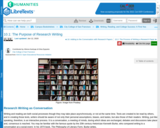
This source discusses the purpose of research writing.
- Subject:
- Composition and Rhetoric
- English Language Arts
- Material Type:
- Textbook
- Provider:
- LibreTexts
- Author:
- Athena Kashyap
- Erika Dyquisto
- Date Added:
- 06/01/2021

This source discusses the purpose of research writing.
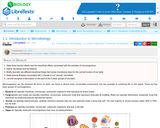
Microorganisms are the dominant life forms on earth, are found in almost every conceivable environment, and are essential to sustaining life on this planet.
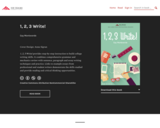
A textbook for WR115 "Introduction to College Writing"
Short Description:
Cover Design: Anne Sigrun 1, 2, 3 Write! provides step-by-step instruction to build college writing skills. It combines comprehensive grammar and mechanics review with sentence, paragraph and essay writing techniques and practice. Links to example essays from professional and student writers demonstrate the skills studied and provide reading and critical thinking opportunities.
Long Description:
1, 2, 3 Write! provides step-by-step instruction to build college writing skills. It combines comprehensive grammar and mechanics review with sentence, paragraph and essay writing techniques and practice. Links to example essays from professional and student writers demonstrate the skills studied and provide reading and critical thinking opportunities.
Word Count: 35250
(Note: This resource's metadata has been created automatically by reformatting and/or combining the information that the author initially provided as part of a bulk import process.)
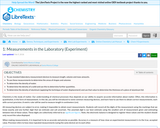
Chemistry is the study of matter. Our understanding of chemical processes thus depends on our ability to acquire accurate information about matter. Often, this information is quantitative, in the form of measurements. In this lab, you will be introduced to some common measuring devices, and learn how to use them to obtain correct measurements, each with correct precision. A metric ruler will be used to measure length in centimeters (cm).
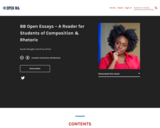
This collection is intended to provide instructors with a wide variety of nonfiction examples of good writing that they can use to teach composition.
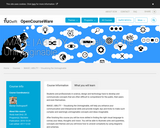
Students and professionals in science, design and technology have to develop and communicate concepts that are often difficult to comprehend for the public, their peers and even themselves.
IMAGE | ABILITY – Visualizing the Unimaginable, will help you enhance your communication and interpersonal skills and provide insight, tips and tricks to make such complex and seemingly unimaginable concepts and ideas imaginable.
After finishing this course you will be more skilled in finding the right visual language to convey your ideas, thoughts and vision. You will be able to illustrate units and quantities, concepts and themes and you will know how to unravel complexity by using diagrams and schemes.

The ACS (American Chemical Society) citation style guide uses color-coded citation examples to assist chemistry students in converting MLA and APA citations to the ACS citation style. The MLA and APA citation styles are widely used in college courses, and many students are familiar with those styles. This guide makes citation in chemistry courses simple by giving examples of frequently referenced resources.
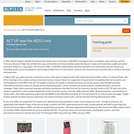
This collection uses primary sources to explore AIDS activism during the 1980s. Digital Public Library of America Primary Source Sets are designed to help students develop their critical thinking skills and draw diverse material from libraries, archives, and museums across the United States. Each set includes an overview, ten to fifteen primary sources, links to related resources, and a teaching guide. These sets were created and reviewed by the teachers on the DPLA's Education Advisory Committee.
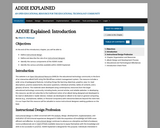
This Open Educational Resource is an interactive eBook in the form of a website titled ADDIE Explained. The eBook focuses on instructional design from the perspective of the ADDIE Model (Analysis, Design, Development, Implementation, and Evaluation) and is designed for novice instructional designers. ADDIE Explained includes a number of educational and technological affordances designed and developed to assist the learners in comprehending the subject matter.
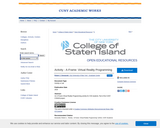
An A-Frame Virtual Reality Programming activity for CS0 students. Part of the CUNY CS04All project.
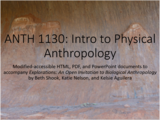
Modified-accessible documents to accompany the text Explorations: An Open Invitation to Biological Anthropology by Beth Shook, Katie Nelson, and Kelsie AguileraFiles include:accessible versions of the lab assignments in HTML format, with student worksheets as a separate documentoriginal PDF copies of the textbook, with the addition of accessible HTML versions of the preface and appendicesaccessible PowerPoint slides
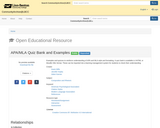
Examples and quizzes to reinforce understanding of APA and MLA style and formatting. A quiz bank is available in XHTML or Moodle XML format. These can be imported into a learning management system for students to check their understanding.
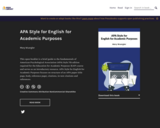
Short Description:
This open booklet is a brief guide to the fundamentals of American Psychological Association (APA) Style 7th edition required for the Education for Academic Purposes (EAP) course and serves as an introductory resource. APA Style for English for Academic Purposes focuses on structure of an APA paper (title page, body, reference page), citations, in-text citations and references.
Word Count: 7036
Included H5P activities: 3
(Note: This resource's metadata has been created automatically by reformatting and/or combining the information that the author initially provided as part of a bulk import process.)
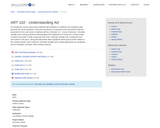
An introductory course using visual materials with emphasis on methods and motivations that generate the visual experience, both past and present. Art practices from around the world are examined for form and content. Emphasis will be on Western Art.
Course Outcomes:
1. Articulate verbally and in writing a general understanding of the significance of visual art in a wide variety of culture and media.
2. Create a personal work of art. Articulate verbally and in writing the form and content of the piece, along with information about significant artists and art works relative to the created artwork, and to visual art.
3. Articulate verbally and in writing appropriate art vocabulary, and art evaluation concepts, when viewing visual art.
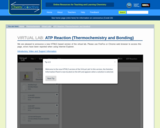
Determine the enthalpy of the ATP reaction.
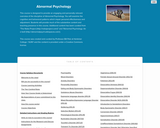
This course is designed to provide an engaging and personally relevant overview of the discipline of Abnormal Psychology. You will examine the cognitive and behavioral patterns which impair personal effectiveness and adjustment. Students will provide much of the substantive content and teaching presence in this course. Additional content has been curated from "The Noba Project (http://nobaproject.com/)" and "Abnormal Psychology: An e-text! (http://abnormalpsych.wikispaces.com/).
Openly-licensed course materials developed for the Open Educational Resources (OER) Degree Initiative, led by Achieving the Dream. https://courses.lumenlearning.com/catalog/achievingthedream
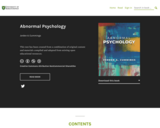
Short Description:
This text has been created from a combination of original content and materials compiled and adapted from existing open educational resources.
Word Count: 112479
ISBN: 978-0-88880-654-3
(Note: This resource's metadata has been created automatically by reformatting and/or combining the information that the author initially provided as part of a bulk import process.)
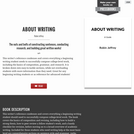
Revised Edition
Short Description:
This writer’s reference condenses and covers everything a beginning writing student needs to successfully compose college-level work, including the basics of composition, grammar, and research. It is broken down into easy-to-tackle sections, while not overloading students with more information than they need. Great for any beginning writing students or as reference for advanced students! Order a print copy: http://www.lulu.com/shop/robin-jeffrey/about-writing/paperback/product-23853977.html
Long Description:
This writer’s reference condenses and covers everything a beginning writing student should need to successfully compose college-level work. The book covers the basics of composition and revising, including how to build a strong thesis, how to peer review a fellow student’s work, and a handy checklist for revision, before moving on to a broad overview of academic writing. Included for those students who need writing help at the most basic level are comprehensive sections on sentence style and grammar, verbs, nouns and other tenets of basic grammar. Finally, the sections on research and citation should help any student find solid evidence for their school work and cite it correctly, as well as encouraging an understanding of why citation is so important in the first place. This is a guide that is useful to writing students of all levels, either as a direct teaching tool or a simple reference.
This revised edition incorporates new sections on revision, citation, and rhetorical concepts. More example text has been provided and the contents have been reorganized to optimize flow and student comprehension. The first edition remains available at About Writing.
Order a print copy: http://www.lulu.com/shop/robin-jeffrey/about-writing/paperback/product-23853977.html
Word Count: 11905
ISBN: 978-1-63635-000-4
(Note: This resource's metadata has been created automatically by reformatting and/or combining the information that the author initially provided as part of a bulk import process.)
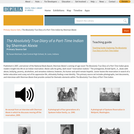
This collection uses primary sources to explore The Absolutely True Diary of a Part-Time Indian by Sherman Alexie. Digital Public Library of America Primary Source Sets are designed to help students develop their critical thinking skills and draw diverse material from libraries, archives, and museums across the United States. Each set includes an overview, ten to fifteen primary sources, links to related resources, and a teaching guide. These sets were created and reviewed by the teachers on the DPLA's Education Advisory Committee.
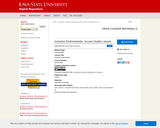
Lecture slides to accompany ARTID 569A: Inclusive Environments, an Interior Design course given at Iowa State University.